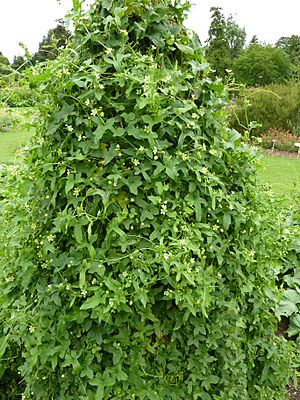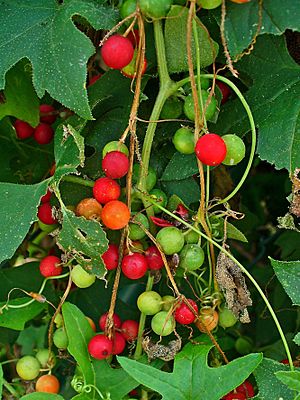Bryonia facts for kids
Quick facts for kids Bryonia |
|
|---|---|
 |
|
| Red bryony (B. dioica) | |
| Scientific classification |
|
| Kingdom: | Plantae |
| Clade: | Tracheophytes |
| Clade: | Angiosperms |
| Clade: | Eudicots |
| Clade: | Rosids |
| Order: | Cucurbitales |
| Family: | Cucurbitaceae |
| Subfamily: | Cucurbitoideae |
| Tribe: | Bryonieae |
| Genus: | Bryonia L. |
| Diversity | |
| 12 species | |
Bryonia is a group of flowering plants that belong to the gourd family. You might know them better by their common name, Bryony. These plants originally come from places like western Eurasia, North Africa, the Canary Islands, and South Asia.
Contents
What are Bryony Plants Like?
Bryony plants are perennial herbs. This means they live for more than two years. They are climbing plants that use special parts called tendrils to grab onto things and grow upwards.
Their leaves look a bit like an open hand, with several lobes or sections. Bryony plants have small flowers that grow in groups where the leaves meet the stem. After the flowers, they produce smooth, round berries.
Who Eats Bryony Plants?
Even though bryony plants can be harmful to humans, some insects use them for food. The young forms (larvae) of certain Lepidoptera (which are butterflies and moths) eat bryony leaves.
For example, the larvae of the tortrix moth called Phtheochroa rugosana feed on red bryony. The cabbage moth (Mamestra brassicae) also uses bryony plants as a food source.
How Do People Use Bryony?
Sometimes, people grow bryony plants in their gardens. This can happen on purpose or by accident. Some types of bryony have been used in herbal medicine for a long time.
However, it's very important to know that these plants are poisonous. Some are extremely dangerous and can even be fatal if eaten. They contain bitter substances called cucurbitacin glycosides, which can make you very sick.
Bryony as a Name
The name "Bryony" (and similar spellings like Briony or Bryonie) is also used as a first name for girls in some cultures. It was quite a popular name in the 1700s.
The Royal Navy in the United Kingdom even named two of their ships HMS Bryony after this plant.
Different Kinds of Bryony
There are about 12 different types, or species, of bryony plants. Here are some of the accepted species:
- Bryonia acuta
- Bryonia alba – This one is known as white bryony.
- Bryonia aspera
- Bryonia cretica – Also called Cretan bryony.
- Bryonia dioica – This is known as white or red bryony. It's the only type that grows naturally in England, often found in hedgerows as far north as Yorkshire.
- Bryonia lappifolia
- Bryonia marmorata
- Bryonia melanocarpa
- Bryonia monoica
- Bryonia multiflora
- Bryonia syriaca
- Bryonia verrucosa
Images for kids
See also
 In Spanish: Bryonia para niños
In Spanish: Bryonia para niños




